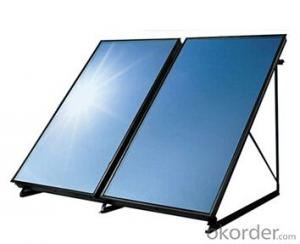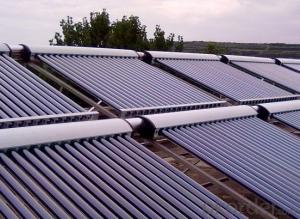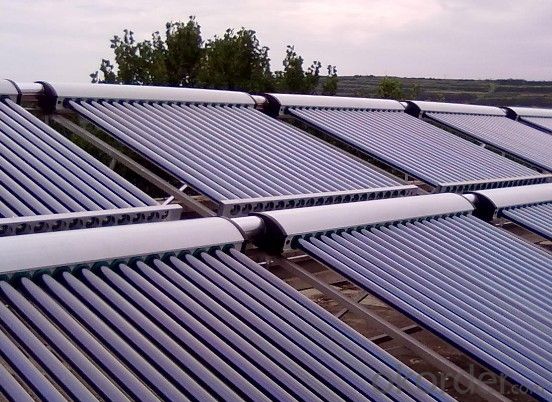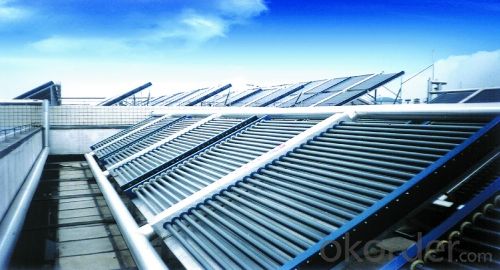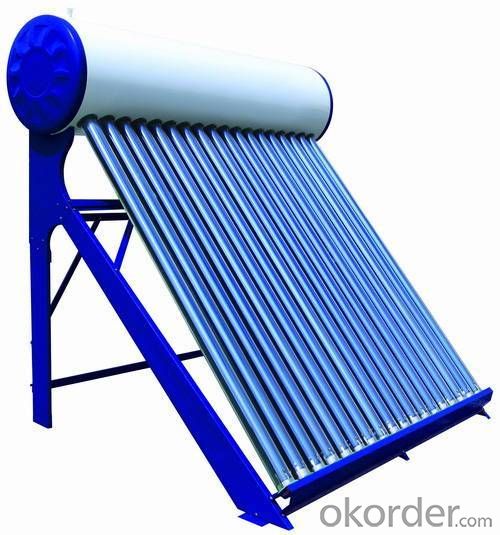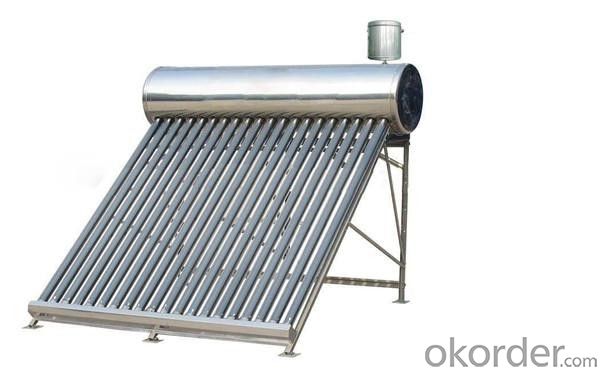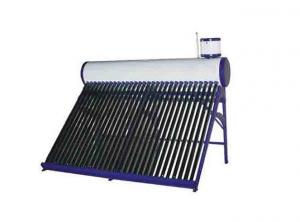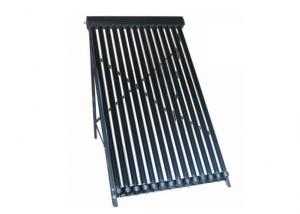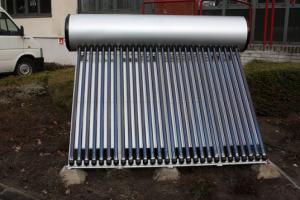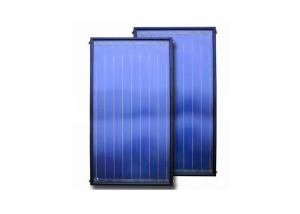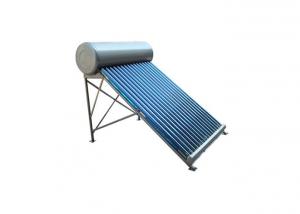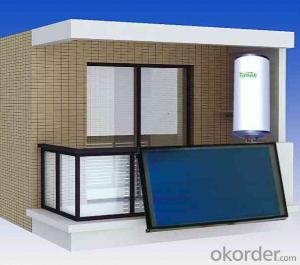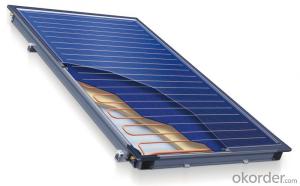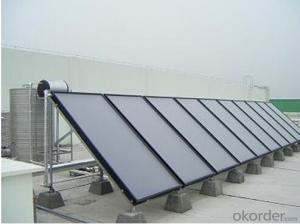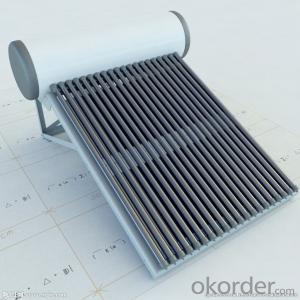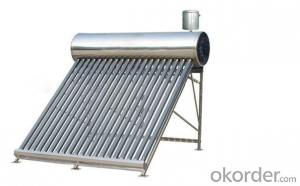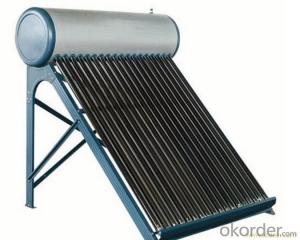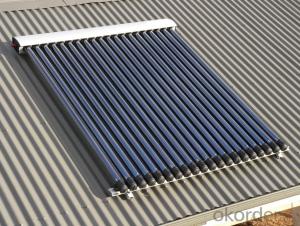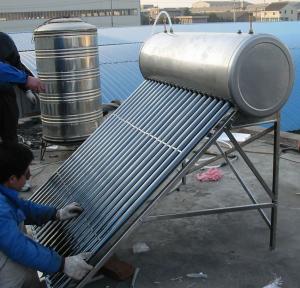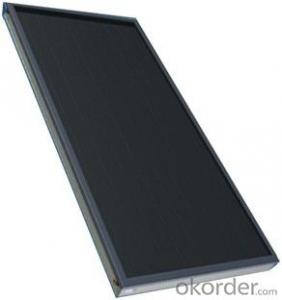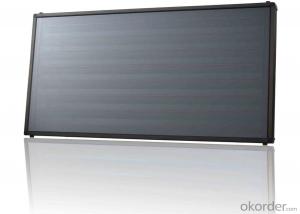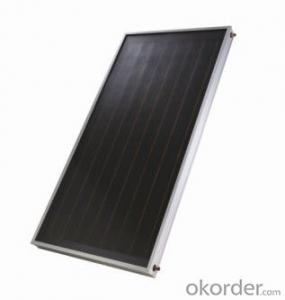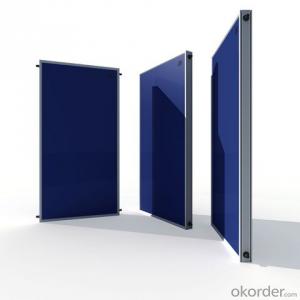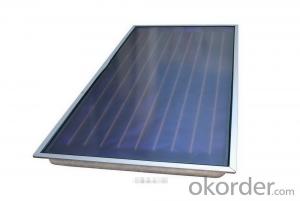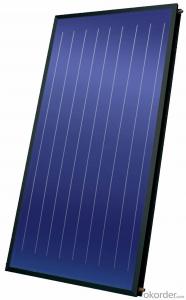Scoop Solar Collectors - 50Tube Vacuum Tube Solar Collector Supplier in China
- Loading Port:
- China main port
- Payment Terms:
- TT OR LC
- Min Order Qty:
- 10 set
- Supply Capability:
- 10000 set/month
OKorder Service Pledge
OKorder Financial Service
You Might Also Like
Introduction of Non-Pressure Solar Water Heater:
Non-pressure Solar Heater is one of the most economical solar water heating device with pretty high efficiency at the same time. It consists of hot water storage tank, solar vacuum tubes with mouth plug in storage tank, and bracket supporting tank and tubes.When cold water in evacuated tubes is heated with solar irradiation, as the specific gravities of hot water and cold water are different, hotter water goes upward to storage tank and colder water goes downward to glass tubes. through this continuous circulation, the cold water in storage tank will be gradually heated till sunset.
Solar water heaters working principle
1. The solar collector absorbs solar energy and transmits it to the solar water heater tank through circulation
2. When the temperature of the collector reaches the set value, the controller starts the circulation pump automatically
3. The circulation pump makes heat-conducting liquid circulate automatically
4. The heat-conducting liquid transfers heat to water by lower heat exchanger in the water tank.
5. When the temperature difference between solar collector and heat pipe solar water heaters tank doesn't reach the set value, the circulation pump will be shut automatically
6. In case the temperature of the water tank does not reach Tmax, Electric Heating Element will start to work automatically
Solar water heaters working station component:
1. Operating screen
2. Manometer
3. Pump speed adjust switches
4. Temperature difference circulation pump
5. Flow rate indicator
6. Return circuit connector
7. Safety valve
Solar water heaters specification:
Description | solar water heaters |
Material of out manifold | 0.55mm thickness color steel/ fluorine carbon steel |
Material of inner tank | Food grade 2.0 mm thickness SUS304 stainless steel |
Tank insulating layer | 40mm 45kg/m³ high-density polyurethane foamed |
Inlet and outlet hole | Male G1'' |
Max pressure | 0.6 Mpa |
Solar collector tube | 3.3 Borosilicate glass with N/Al coating |
Thickness of glass tube | 1.6mm |
Vacuum tube tightness | P≤0.005 Pa |
Absorption | as=0.93-0.96 (AM1.5) |
Emission ratio | εh=0.04-0.06 (80C±5C) |
Idle sunning property parameters | Y=220~260m2.C/KW |
Average heat loss coefficient | ULT=0.6~0.7W/(m2.C) |
Bracket: | 2.0mm thickness aluminum alloy |
Tank weight | 75KGS |
Tank size | 560mm Dia x 1810mm Height |
Tank capacity | 300L |
Solar collector | 2pcs 58x1800x15tube solar collector |
Absorber area | 2.811 m² |
Working station | SP116 working station |
Heat exchanger length | Upper:12m, Underside:18m |
Solar water heaters details show:
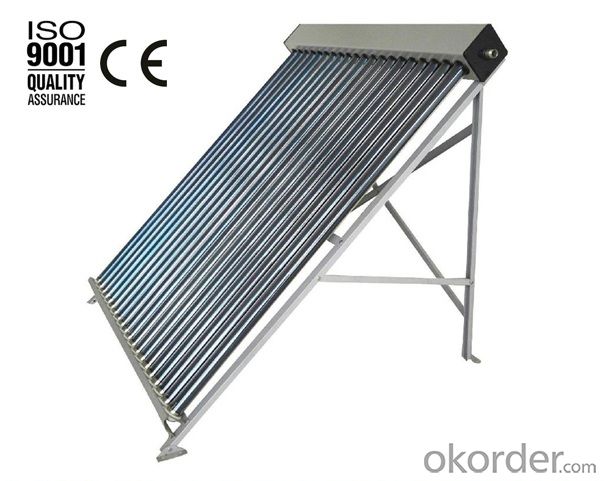
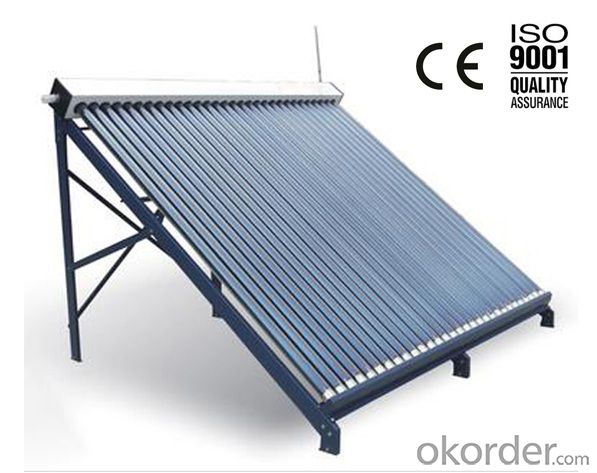
Benefits of this kind of solar water heaters:
1. Prolong the life of your existing water heater
2.Costs less than an electric, gas or oil water heater
3.No maintenance required
4.Lasts longer than a traditional hot water heater
5.Reduce your water heating costs
- Q: How do solar collectors perform in extreme weather conditions?
- Solar collectors have been specifically designed to withstand and function effectively in different weather conditions, including extreme ones. In cold weather, solar collectors are equipped with insulation and anti-freezing mechanisms to prevent any damage caused by freezing temperatures. These mechanisms guarantee that the fluid circulating within the collectors remains unfrozen, which prevents any cracks or harm to the system. On the other hand, solar collectors have been constructed to handle high temperatures during extremely hot weather without compromising their performance. They are made from durable materials that can endure the heat and maintain their efficiency, even under scorching conditions. Moreover, the design incorporates proper ventilation and cooling systems to prevent overheating and optimize the overall performance of the system. During heavy rain or snowfall, solar collectors have been specifically designed to shed water and prevent any accumulation on their surface. This design feature ensures that the panels can continue to operate efficiently by minimizing any interference caused by water or ice. Additionally, solar collectors are built to be sturdy and durable, capable of withstanding strong winds, hail, or any other severe weather conditions. It is important to note that extreme weather conditions may temporarily affect the output of solar collectors, as solar radiation may be reduced or blocked. However, modern solar collectors have been designed to optimize energy absorption and conversion even in less than ideal conditions. Furthermore, solar collectors can be installed at the most optimal angle and orientation to maximize their performance throughout the year, taking into consideration the specific weather patterns of the region. All in all, solar collectors have been engineered to be resilient and function well in extreme weather conditions. They undergo rigorous testing and certifications to ensure their durability and efficiency under various environmental circumstances. With proper installation and regular maintenance, solar collectors can continue to generate clean and renewable energy even in the face of challenging weather conditions.
- Q: Can solar collectors be used in areas with limited skilled labor?
- Yes, solar collectors can be used in areas with limited skilled labor. Solar collectors are relatively simple to install and maintain, requiring basic technical knowledge. Additionally, many manufacturers provide training and resources to support the installation and maintenance process. Furthermore, there are organizations and initiatives aimed at promoting solar energy in developing regions, which often include capacity-building programs to train local individuals in the necessary skills.
- Q: Can solar collectors be used for heating barns?
- Yes, solar collectors can be used for heating barns. Solar collectors, such as solar thermal panels or air collectors, can harness the sun's energy to provide heat for barns. This renewable energy source can help reduce heating costs and provide a sustainable heating solution for barns.
- Q: What is the effect of snow on solar collectors?
- The effect of snow on solar collectors is that it can significantly reduce their efficiency and output. Snow accumulation on the surface of the collectors blocks sunlight from reaching the photovoltaic cells, preventing them from converting sunlight into electricity. Additionally, snow can create a barrier between the collectors and the sun, limiting their ability to absorb solar energy and heat. Therefore, it is necessary to regularly remove snow from solar collectors to maintain their optimal performance.
- Q: Can solar collectors be used for heating factories?
- Yes, solar collectors can be used for heating factories. Solar thermal systems can provide heat for various industrial processes, including heating factories, by capturing sunlight and converting it into thermal energy. This renewable energy source can significantly reduce reliance on traditional fossil fuel heating systems, leading to cost savings and environmental benefits.
- Q: Can solar collectors be used for heating libraries?
- Yes, solar collectors can be used for heating libraries. Solar collectors are capable of harnessing sunlight and converting it into thermal energy, which can then be used to provide warmth for indoor spaces. By installing solar collectors on the roof or nearby areas, libraries can utilize solar energy to heat their premises, reducing reliance on traditional heating systems and promoting sustainability.
- Q: Can solar collectors be used for heating greenhouse spaces?
- Yes, solar collectors can be used for heating greenhouse spaces. Solar collectors, such as solar thermal panels or solar air heaters, can harness the sun's energy to provide heat for greenhouse spaces. This renewable energy source can help maintain optimal temperatures for plant growth while reducing reliance on traditional heating methods, making it an environmentally friendly and cost-effective solution for greenhouse heating.
- Q: Are solar collectors cost-effective?
- Yes, solar collectors are cost-effective in the long run. Although the initial investment may be higher compared to traditional energy sources, the long-term savings on electricity bills and the potential for government incentives make solar collectors a financially viable option. Additionally, the decreasing cost of solar technology and the ability to generate clean and renewable energy contribute to their overall cost-effectiveness.
- Q: What is the purpose of a solar collector?
- The purpose of a solar collector is to capture and convert solar energy into usable heat or electricity.
- Q: Can solar collectors be used in advocacy for renewable energy?
- Yes, solar collectors can definitely be used in advocacy for renewable energy. Solar collectors, also known as solar panels or solar photovoltaic (PV) systems, are a prime example of harnessing solar energy to generate electricity. By showcasing the effectiveness and benefits of solar collectors, advocates can highlight the potential of renewable energy sources like solar power. This helps raise awareness about the importance of transitioning to clean and sustainable energy alternatives, ultimately contributing to the overall promotion and adoption of renewable energy.
Send your message to us
Scoop Solar Collectors - 50Tube Vacuum Tube Solar Collector Supplier in China
- Loading Port:
- China main port
- Payment Terms:
- TT OR LC
- Min Order Qty:
- 10 set
- Supply Capability:
- 10000 set/month
OKorder Service Pledge
OKorder Financial Service
Similar products
Hot products
Hot Searches
